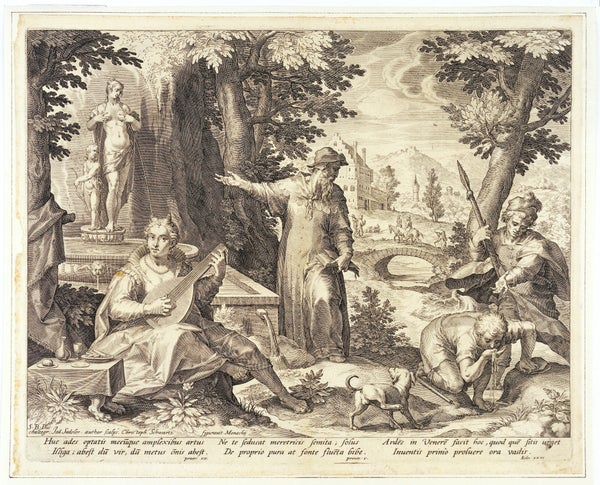Renaissance Italy was full of new ideas; cultural and economic rebirth; and artistic fervor, and it produced some of the most notable scientific work Europe had seen for centuries. It was also a time of syphilis. The first recorded outbreak occurred in 1494/95 in the city of Naples, after which it spread rapidly throughout Europe.
As a physician in Verona, Girolamo Fracastoro observed the mortifying effects of the disease firsthand. More virulent and contagious than syphilis today, the disease would be responsible for an estimated five million deaths throughout the continent. Its symptoms were particularly visual and included widespread bodily lesions.
Born in Verona in the Republic of Venice in 1478 to a family of high standing, Fracastoro was by 1502 appointed professor at the University of Padua, where his contemporaries included a certain Nicolaus Copernicus. He would study logic and anatomy at the University of Padua, before moving to Verona, where he maintained a private practice. In 1545 he was elected to the Council of Trent in service of Pope Paul III, and it was Fracastoro who in March 1547 persuaded the council to move to the papal state of Bologna because of the danger of plague in Trent.
On supporting science journalism
If you're enjoying this article, consider supporting our award-winning journalism by subscribing. By purchasing a subscription you are helping to ensure the future of impactful stories about the discoveries and ideas shaping our world today.
A true Renaissance thinker, Fracastoro exhibited interest in multiple fields. His works include a treatise concerning the constitution of wine (Di Vino Temperatura), dialogues regarding poetics and the nature of the soul, epic poems about Old Testament figure Joseph, and more lengthy works concerning astronomy (Fracastoro advocated for a homocentric model of the universe, in contrast with Copernicus), the nature of contagious diseases, geology, and philosophy.
It is typical of the interdisciplinary nature of Fracastoro’s interests that his most well-known work should be a Latin poem, composed in hexameter and infused with mythology, about a contagious disease. Published in 1530, the epic poem Syphilis sive Morbus Gallicus (Syphilis or the French Disease), from which the disease derives its name, was influential in understanding and treating the disease. The manuscript edition was completed in 1521 and widely disseminated, to the extent that Fracastoro eventually went to print to prevent errors that might occur from reproduction of the text by hand.
Following his work on Syphilis, widely praised at the time for its poetic elegance as much as any scientific merit, Fracastoro would dedicate himself to the study of contagion well into the 1540s.
In 1546, Fracastoro published De Contagione et Contagiosis Morbis (On Contagion and Contagious Diseases). Books I and II contain Fracastoro’s theory of the mechanisms of contagion, followed by discussions of a number of different contagious diseases including typhus, syphilis and leprosy. Book III puts forward several cures for common diseases, as well as one of the earliest advocacies of personal hygiene to prevent disease spread.
It is Fracastoro’s theories regarding the nature of contagious diseases that have attracted scholarly attention. Fracastoro believed that diseases were caused by imperceptible seedlike entities (seminaria) which could multiply rapidly, propagate quickly, and were unique to each disease.
He posited that these seeds could spread in three distinct ways. Firstly, by direct contact (including shaking hands), secondly, by indirect contact through fomites (inanimate objects such as clothing), and lastly over long distances through the air, emphasizing that the thing that binds the three modes of transmission together is that all are “contagious by direct contact.” While some of these ideas had been considered by previous scholars, Fracastoro was the first to fuse the three causes of transmission into a coherent theory of contagion.
His theory of “seeds of disease” was particularly innovative; other scholars had speculated on cause of transmission through air, but only Fracastoro went as far as to “invent another order of living things,” as historian Vivian Nutton puts it (though Fracastoro’s conceptions were living, they were of a completely different ilk to the contagium vivum fluidum of Martinus Beijerinck in the late 19th century). The “seeds of disease” were almost certainly influenced by Democritean atomism and took inspiration from the Roman poet Lucretius, whose work had been rediscovered in the 15th century.
Fracastoro’s theory of contagion, though discussed by his contemporaries, did not have a lasting impact upon the course of epidemiology, in part owing to the fact that his theory of seeds could justifiably be interpreted within Galenic tradition as being consistent with the miasma theory that prevailed at the time. The medical community would remain divided on the topic of disease proliferation for the most part of the next three centuries, well after Fracastoro’s death in 1553.
Miasma theory, which posited that contagious diseases were caused by bad air, would persist well into the 1800s at the expense of contagionist theory. Only when an experimental germ theory was developed by Robert Koch and Louis Pasteur in 1861 would contagionist theory begin to dominate.
The bacteriologists of the 19th century would revive Fracastoro’s works, pointing to his “seeds of disease” theory of contagion as an early forerunner of microorganisms and the first true understanding of the nature of contagion.
While academics agree that Fracastoro was an important Renaissance figure in the field of medicine, discourse differs as to whether Fracastoro should be remembered as a forefather of germ theory or as a scholar whose metaphor of “seeds” has been exaggerated to fit with more modern discoveries.
In an age of coronavirus, though, we should perhaps thank him most for his early advocacy of personal hygiene.
